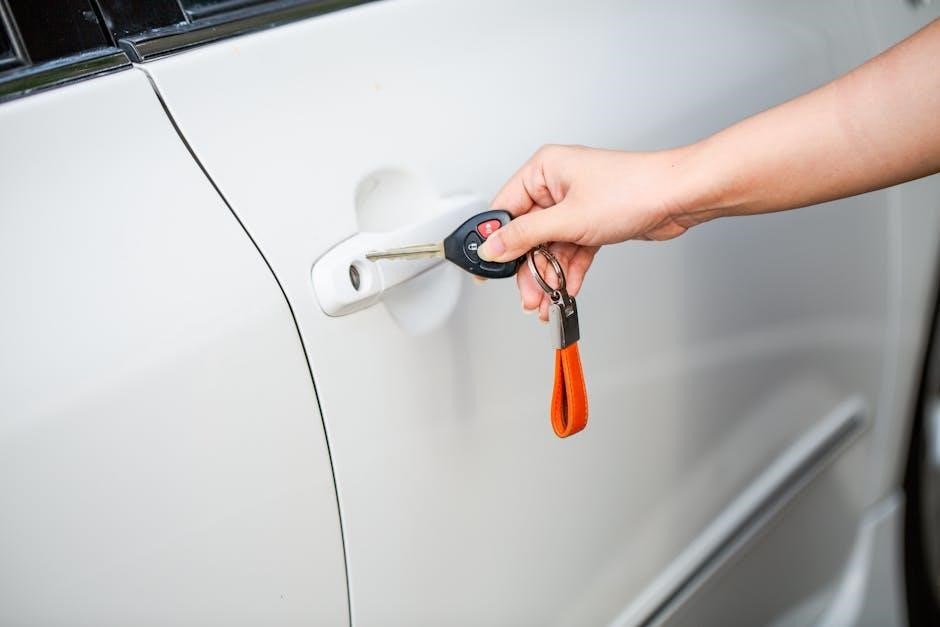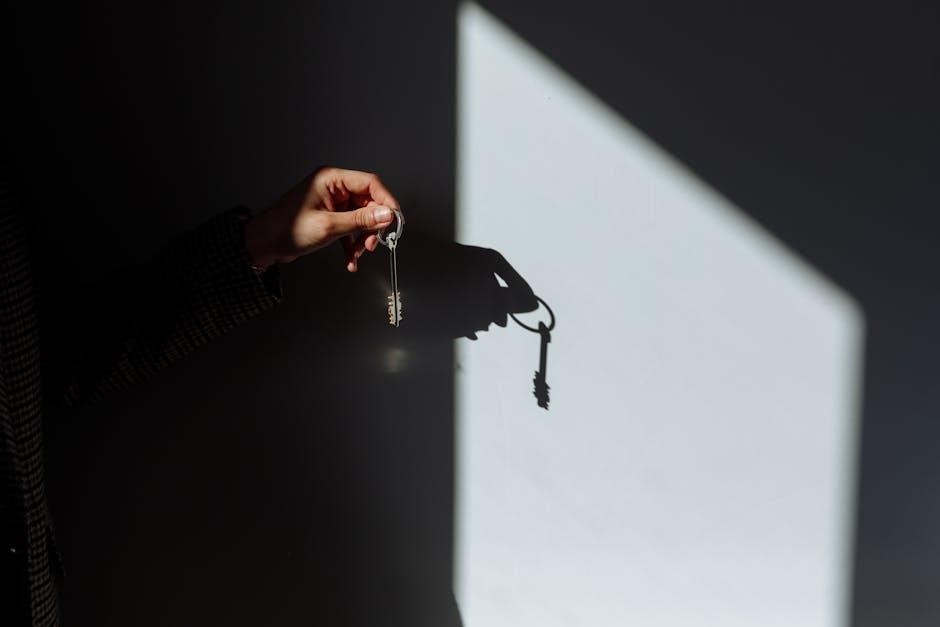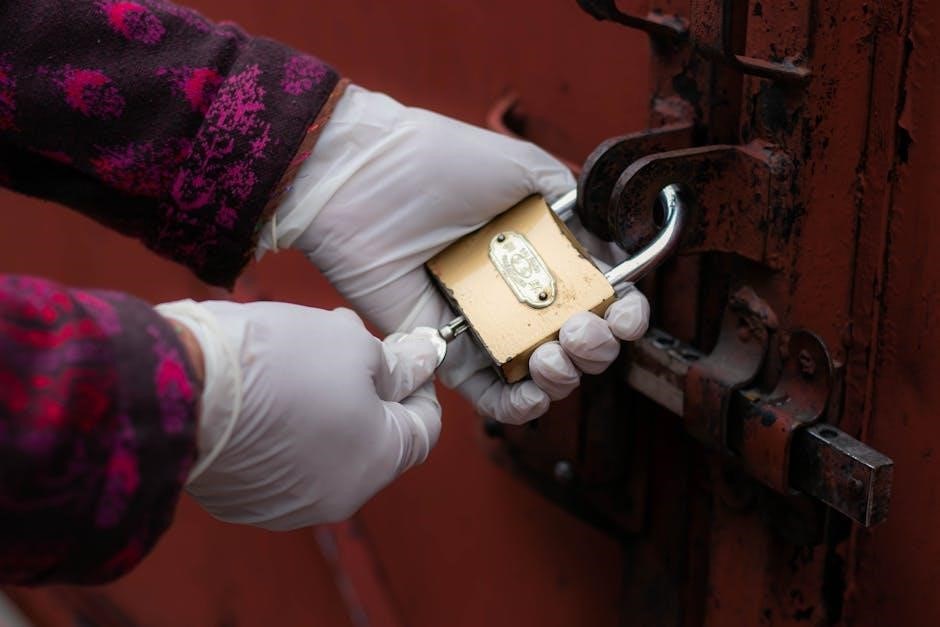Manual Key Won’t Unlock Car Door: Troubleshooting Guide
Discovering your manual key won’t unlock your car door can be a frustrating experience. This guide provides a systematic approach to diagnosing and resolving the issue‚ covering common causes and offering practical solutions to regain access to your vehicle.
Common Reasons for Manual Key Failure
Several factors can contribute to a manual key’s failure to unlock a car door. A primary suspect is wear and tear on the key itself‚ causing it to no longer align correctly with the lock’s tumblers. Similarly‚ damage to the lock cylinder‚ such as bent or broken pins‚ can impede the key’s ability to turn.

Accumulation of dirt‚ dust‚ and debris within the keyhole can obstruct the key’s smooth insertion and rotation. Lack of lubrication in the locking mechanism can also create friction‚ hindering the key’s movement. In colder climates‚ frozen car door locks are a common issue. A stuck door latch or a faulty actuator‚ small motor that controls the locking mechanism in your car door. Finally‚ a dead car battery can sometimes impact the central locking system‚ preventing manual unlocking.
Worn Key or Damaged Lock Cylinder
One of the most frequent culprits behind a malfunctioning manual key is either a worn key or a damaged lock cylinder. Over time‚ the constant use of a key can lead to its gradual wear and tear. The ridges and grooves that are designed to match the internal mechanism of the lock become rounded or flattened‚ preventing the key from properly engaging with the tumblers inside the lock cylinder.
Alternatively‚ the lock cylinder itself can suffer damage. The lock cylinder is made up of several components‚ including pins‚ tumblers‚ and springs that work together to turn the key and unlock the door. The tumblers are most prone to damage.
Key Wear and Tear
A frequently used key undergoes significant wear and tear‚ leading to its inability to properly engage with the lock mechanism. Over time‚ the precise cuts and grooves on the key’s surface gradually erode‚ diminishing its original shape. This erosion prevents the key from aligning correctly with the intricate series of pins and tumblers within the lock cylinder‚ which are essential for initiating the unlocking process.

When the key’s contours become excessively worn‚ it may feel loose or exhibit difficulty when inserted into the lock. The worn key may fail to turn the cylinder effectively‚ or it might get stuck altogether.
Lock Cylinder Damage (Pins‚ Tumblers)
The lock cylinder houses delicate components like pins‚ tumblers‚ and springs‚ vital for correct key operation. These parts can suffer damage from wear‚ corrosion‚ or foreign object intrusion. The cylinder’s tumblers‚ small brass plates within the core‚ are particularly vulnerable. They align with key cuts to turn the cylinder and unlock the door.
When damaged‚ tumblers stick‚ failing to align with the key‚ preventing the lock from turning. Dirt‚ grime‚ and corrosion hinder parts‚ affecting key engagement. A broken tailpiece stops key engagement with the locking mechanism. Inspect for wear‚ corrosion‚ and damage. If present‚ professional repair or replacement is essential to restore functionality.
Dirt and Debris in the Keyhole
The keyhole‚ a narrow opening‚ is susceptible to accumulating dirt‚ dust‚ and debris. This buildup interferes with the key’s smooth rotation‚ preventing it from fully engaging the lock mechanism. Repeated key insertion can wear down the keyhole‚ increasing friction and hindering proper turning.
A cluster of dust can trap the key‚ stopping it from unlocking the car. Regular use in dirty conditions accelerates debris accumulation. Lubricating the lock offers temporary relief‚ but thorough cleaning or eventual replacement is necessary. This is especially true if contamination persists. Addressing this issue ensures the key interacts properly.
Lack of Lubrication

Car door locks‚ though generally low-maintenance‚ can suffer from metal parts wearing out or seizing up with regular use. A key turning difficulty often signals a need for lubrication. Applying graphite powder or lock oil to the key grooves before insertion can help. However‚ avoid over-lubrication‚ as excess lubricant attracts dirt and grime‚ worsening the problem.
If you have been using the key fob‚ and then try using the mechanical keys after a while‚ it may happen. Regular lubrication maintains smooth lock operation. It prevents friction-induced wear. This simple step extends the life of your car door’s locking mechanism.
Frozen Car Door Locks
For drivers in colder climates‚ frozen locks present a common obstacle. Sub-freezing temperatures cause moisture inside the lock to freeze‚ rendering the key immobile. A de-icer spray offers a quick solution‚ melting the ice and restoring lock function without damage.
Preventive measures include applying a water-displacing lubricant before winter. This minimizes moisture buildup inside the lock cylinder. If freezing occurs‚ avoid forcing the key. This can cause damage to the key or the lock mechanism. Patience and the use of a de-icer will get you back in your car quickly.
Stuck Door Latch
Even with a functioning lock‚ a stuck door latch can prevent entry. Rust and corrosion hinder the latch’s free movement‚ keeping the door sealed. This issue arises independently of key or lock problems. If the key turns but the door remains stuck‚ suspect a faulty latch.
Lubrication offers a temporary fix‚ freeing the latch mechanism. However‚ a comprehensive repair might become necessary for long-term functionality. Test other doors and the trunk to pinpoint the issue. If other doors open‚ the latch is the likely culprit. Addressing a stuck latch ensures smooth door operation.
Dead Car Battery Impact
A dead car battery can indirectly cause your manual key to fail. Modern vehicles rely on electrical systems for various functions‚ including door locking mechanisms. A dead battery can disrupt these systems‚ preventing the manual key from properly engaging the lock.
Symptoms of a dead battery include a non-responsive central locking system and dim or non-existent interior lights. Even if the manual key turns‚ the door might not unlock due to electrical interference. Addressing the dead battery is crucial to restoring full functionality. Consider jump-starting or replacing the battery to resolve this issue and regain access to your car.
Faulty Actuator
The actuator‚ a small motor within the door‚ controls the locking mechanism. When the actuator malfunctions‚ even a correctly turned manual key might fail to unlock the door. Actuator failure can stem from wear and tear‚ electrical problems‚ or damage from environmental factors like water.
Symptoms include the key turning without unlocking‚ unusual noises from the door‚ or inconsistent locking behavior. Diagnosing a faulty actuator often requires professional assessment. Replacement or repair is typically necessary to restore the door’s locking function. Ignoring this issue can leave you stranded. Always seek professional help when you cannot resolve this problem.
DIY Solutions to Try
Before seeking professional help‚ explore several do-it-yourself solutions. Start by lubricating the lock mechanism to address potential stiffness. A de-icer spray can thaw frozen locks in colder climates. For more complex issues‚ consider using a slim jim alternative‚ but exercise caution to avoid damage.
Smartphone apps can also be useful if your car has keyless entry features. If these methods fail‚ it’s best to consult a locksmith. DIY attempts can save time and money‚ but prioritize caution. Always be careful when using a tool on your vehicle. If you are not a mechanic‚ consult a professional.

Lubricating the Lock
If your manual key won’t unlock your car door‚ lack of lubrication might be the culprit. Over time‚ the internal mechanisms of the lock can become stiff‚ hindering the key’s ability to turn smoothly. Applying a lubricant directly into the keyhole can often resolve this issue. Graphite powder or lock oil are suitable choices‚ but use them sparingly to prevent attracting dirt and grime.
Insert the key and gently wiggle it to distribute the lubricant throughout the lock. Avoid using excessive force‚ as this could damage the delicate components within the lock cylinder. Test the key’s functionality after lubrication; repeating the process might be necessary for optimal results.
Using a De-Icer
In colder climates‚ frozen car door locks are a frequent problem. When temperatures plummet‚ moisture inside the lock mechanism can freeze‚ rendering the manual key useless. Attempting to force the key can cause damage‚ so a de-icer spray is the recommended solution.
De-icer sprays contain chemicals that rapidly melt ice‚ allowing the key to turn freely. Apply the de-icer directly into the keyhole‚ following the product’s instructions. Allow a few moments for the ice to thaw before gently attempting to turn the key. Avoid using hot water‚ as it can refreeze and exacerbate the problem.
Once the lock is free‚ lubricate it to prevent future freezing.
Slim Jim Alternative
When locked out of your car‚ and a slim jim isn’t available‚ consider alternative methods that can help manipulate the locking mechanism. One such alternative involves using an inflatable door wedge. This wedge is carefully inserted between the car door and the frame‚ and then inflated to create a small gap.
Once the gap is sufficient‚ a long reach tool or a rod can be inserted to manually trigger the lock. This requires patience and a gentle touch to avoid damaging the internal components. Another method involves using a shoestring to create a loop around the door’s lock‚ attempting to pull it upward to unlock the door.
These techniques may work best on older vehicles.
When to Call a Locksmith
If you’ve exhausted all DIY solutions‚ such as lubrication‚ de-icing‚ or alternative entry methods like using a slim jim or shoestring‚ and your manual key still refuses to unlock your car door‚ it’s time to call a professional locksmith. Locksmiths possess specialized tools and expertise to handle complex lock mechanisms without causing damage to your vehicle.
They can diagnose underlying issues‚ such as a broken tailpiece or faulty actuator‚ that prevent the key from engaging correctly. Additionally‚ if your car has advanced security features or a damaged lock cylinder‚ a locksmith can provide safe and efficient solutions.
Expect to pay anywhere from $50 to $250 for labor‚ depending on the complexity.
Preventative Measures and Maintenance
To minimize the risk of being locked out of your car due to a malfunctioning manual key‚ implementing preventative measures and regular maintenance is crucial. Regularly lubricate the lock cylinder with graphite powder or lock oil to prevent dirt and debris buildup‚ ensuring smooth key operation. Inspect your key for wear and tear‚ such as bending or chipping‚ and replace it promptly if necessary.
Avoid forcing the key into the lock‚ as this can damage both the key and the cylinder. In colder climates‚ use de-icer spray to prevent frozen locks. By proactively addressing potential issues‚ you can enhance the reliability of your manual key and avoid inconvenient lockouts.
Spare Key Options (Standard‚ Transponder‚ Smart)
Having a spare key readily available is a vital preventative measure against car lockouts. Standard metal keys are the most basic and affordable option‚ suitable for older vehicles without advanced security features. Transponder keys‚ equipped with a microchip‚ offer enhanced security by communicating with the car’s immobilizer system. These keys require programming to match the vehicle’s unique code.
Smart keys‚ the most advanced type‚ provide keyless entry and push-button start functionality. They use radio signals to communicate with the car‚ offering convenience and security. When choosing a spare key‚ consider your vehicle’s security features and budget to ensure reliable access in case of emergencies. Remember to store the spare key in a safe‚ accessible location.

